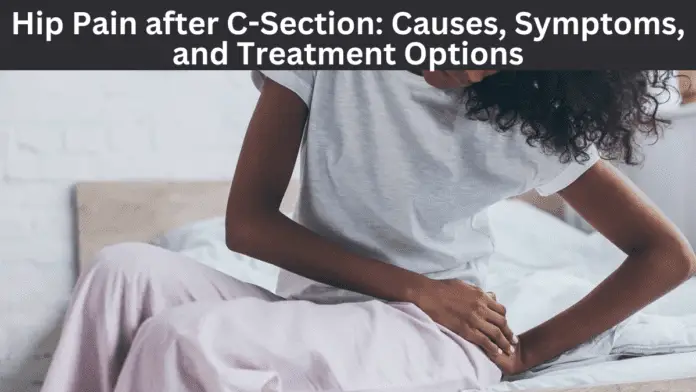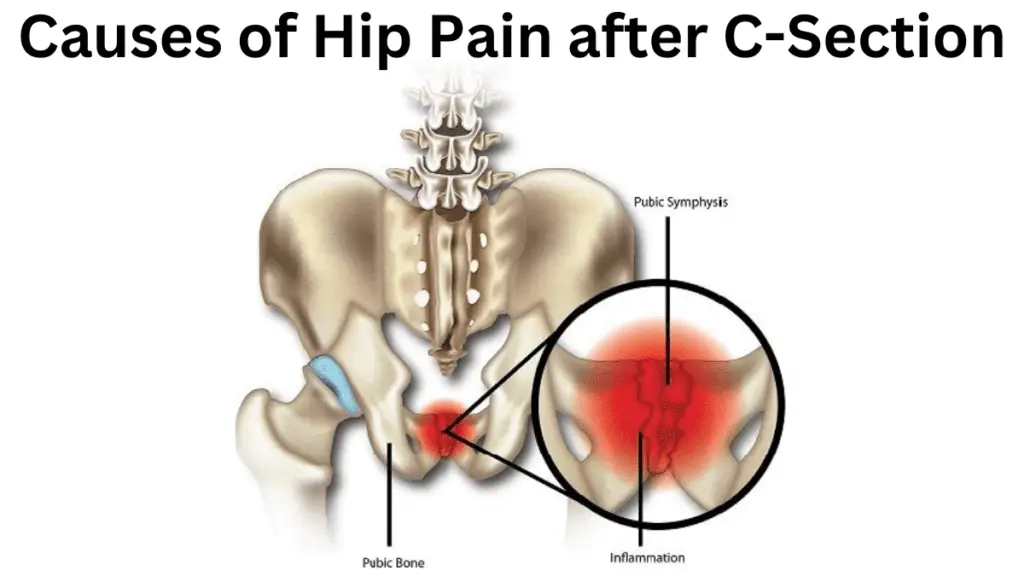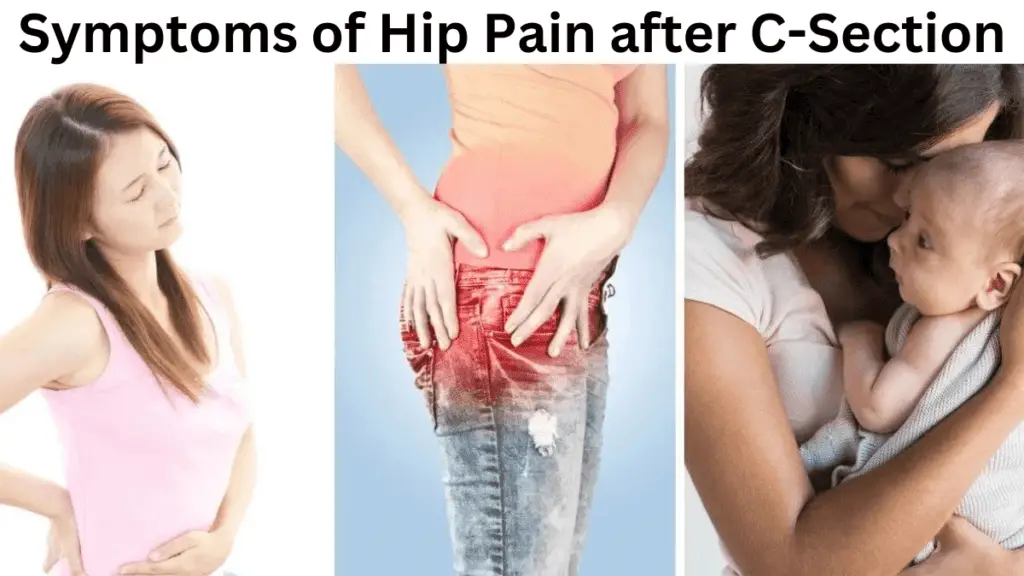
Having a cesarean section, commonly known as a C-section, is an increasingly common way to deliver a baby. According to the World Health Organization, more than 25% of births in the United States are now deliveries by C-section. Although this surgical procedure has many benefits for both mother and child, it can also result in hip pain after delivery. In this article, we will discuss what causes hip pain after C-section and provide information about potential treatments.
Causes of Hip Pain after C-Section

Physical Trauma during Surgery
During a C-section, the abdomen is cut open, resulting in physical trauma to the surrounding muscles and tissue. This can cause hip pain if the incision or other surgery-related trauma impacts the hip joint or nearby nerves.
Postural Changes During Pregnancy
During pregnancy, a woman’s body undergoes natural postural changes due to the growing baby in her abdomen. These changes can create tension and strain on the hip muscle or joints, leading to pain after delivery.
Scar Tissue Formation
After a C-section, scar tissue often forms around the incision and can cause pain or discomfort when it presses on surrounding muscles or nerves.
Nerve Damage
The nerves in the hips, pelvic area, and abdomen may become damaged due to surgical trauma or scar tissue formation. This can lead to radiating hip pain after C-section.
Read: Can You Have Pelvic Floor Issues After C-Section?
Symptoms of Hip Pain after C-Section

- Pain in the Hip Area – A common symptom of hip pain after C-section is pain in the hip or groin area. This may range from sharp, stabbing sensations to dull, aching discomfort that persists for days or even weeks.
- Limited Range of Motion – Post-cesarean hip pain can also make it difficult to move the hip joint freely. This can lead to a reduced range of motion, making it difficult for new mothers to sit or walk comfortably.
- Difficulty Sitting or Standing for Long Periods of Time – If a woman has hip pain after C-section, she may experience difficulty sitting or standing for long periods of time. This may lead to difficulty performing everyday tasks, such as cooking or cleaning.
- Difficulty Walking – Post-cesarean hip pain can also make it difficult for mothers to walk correctly and comfortably, often leading to an altered gait or limping.
- Inflammation or Swelling – Inflammation or swelling around the hip joint can be another symptom of hip pain after C-section. This may be accompanied by redness, warmth, or tenderness in the area.
Diagnosis of Hip Pain after C-Section
- Physical Examination: A doctor can diagnose hip pain after c-section through a physical examination. During this exam, the doctor will check for any tenderness or swelling around the area as well as assess any range of motion issues. The doctor may also ask the patient to perform specific movements or activities in order to identify any mobility issues.
- Medical Imaging: Another method of diagnosing hip pain after c-section is through medical imaging. This may include an X-ray, MRI, or ultrasound to look for any structural issues such as fractures, cysts, bone spurs, or nerve damage.
- Blood Tests: In some cases, doctors may also perform blood tests to rule out any other potential causes of hip pain such as infections or arthritis.
Treatment Options for Hip Pain after C-Section
Once the cause of the hip pain has been identified, a doctor can recommend an appropriate treatment plan.
- Rest: Rest is often the first step of treatment for hip pain after c-section. This means limiting activities and giving the body time to heal and recover from the trauma of surgery.
- Ice or Heat Therapy: Applying either ice or heat to the affected area can help reduce inflammation and pain in the hip joint.
- Medications: Non-steroidal anti-inflammatory drugs (NSAIDs) can help reduce swelling and pain associated with hip pain after c-section.
- Physical Therapy: A physical therapist can provide exercises to help strengthen the hip muscles and restore range of motion in the joint.
- Surgery: In rare cases, surgery may be recommended to treat more severe hip pain after c-section. This may involve repairing any damage to the joint or removing scar tissue that is pressing on nerves.
Preventing Hip Pain after C-Section
Although it is impossible to completely prevent hip pain after c-section, there are certain measures that can be taken to minimize the risk.
Early Mobilization
A key component of preventing hip pain after C-section is early mobilization. This means getting up and moving as soon as possible, even if it’s just for brief periods of time each day. Early movement can help reduce scar tissue formation, improve blood circulation, and reduce inflammation. It is important to start with low-impact movements, such as walking or gentle stretching.
Exercises to Strengthen Hip Muscles
Regular exercises can also help strengthen the hip muscles and improve the range of motion in the joint. This can include simple bodyweight exercises or using resistance bands or weights for more challenging moves. It is important to begin slowly and gradually increase the intensity as the body adjusts.
Must Read: An Easy Beginner-Friendly Cardio Workout
Proper Lifting Techniques
One of the most important things a woman can do to prevent hip pain after C-section is to use proper lifting techniques. When lifting heavy objects, it is important to bend at the knees and use your legs for support instead of straining or putting too much pressure on the hip joint.
Good Posture
Maintaining good posture is also important in preventing hip pain after C-section. This means sitting and standing with your back straight, shoulders relaxed, and feet firmly planted on the ground. Poor posture can put an unnecessary strain on the hip muscles and lead to discomfort or pain.
Avoiding High-Impact Activities
Finally, it is important to avoid high-impact activities such as running or jumping until the body has fully recovered from the surgery. These activities can be too intense for a woman’s body in the weeks and months after giving birth, so it is best to stick with more gentle exercises until you are fully healed.
Coping Strategies for Hip Pain after C-Section
Mindfulness and Meditation
Mindfulness meditation is a great way to cope with the pain associated with hip pain after c-section. This practice involves focusing on the present moment without judgement or expectations, which can help reduce anxiety, improve focus, and promote relaxation. Guided meditation can also be used to help manage pain by teaching a person how to observe their own thoughts and feelings without being overwhelmed by them.
Support Groups
Women who have experienced hip pain after c-section can benefit from joining support groups specifically designed for this purpose. These groups provide an opportunity to connect with others in similar situations while learning new coping strategies and receiving emotional support from peers.
Assistive Devices
Assistive devices such as braces, slings, or a cane can provide additional support and stability when walking or performing certain activities. These devices can help reduce strain on the hip joint, allowing individuals to better manage their symptoms and stay more active despite their pain.
Yoga
Gentle yoga practices can also be beneficial for those suffering from hip pain after C-section as they are designed to improve flexibility while increasing strength in the muscles that support the hips. Certain poses such as cat/cow pose, warrior II, bridge pose, and half moon pose, may be particularly helpful for managing hip discomfort after childbirth.
Massage Therapy
Massage therapy can help relax tense muscles around the hips and relieve some of the discomfort associated with postpartum hip pain. It may also assist in improving circulation and helping the body recover more quickly from surgery-related trauma.
When to Seek Medical Attention
- Signs of Infection: If you experience any signs or symptoms of infection, such as redness, warmth, swelling, fever, and chills in the area around your C-section scar or another part of your body, seek medical attention right away.
- Pain Intensity and Duration: Hip pain after C-section may come and go over the months following childbirth. However, if the pain persists for more than a few weeks or becomes more intense over time, it is important to contact your doctor to discuss further treatment options.
- Difficulty Walking or Standing: If you are finding it difficult to walk or stand due to hip pain after C-section, this could be an indication that something else is going on, and you should consult with your doctor.
- Changes in Bowel or Bladder Function: In addition to experiencing hip pain after C-section, some women may also experience changes in their normal bowel or bladder function. This can include difficulty urinating or having an urge to urinate frequently throughout the day. If this occurs along with hip pain, it is important to seek medical attention as soon as possible.
Read: How to Get Rid of Post C-Section Belly Overhang
Frequently Asked Questions
How long does hip pain last after C-section?
Hip pain after C-Section can be expected to last for up to several weeks or even months, depending on the individual and the severity of their pain. It is important to follow your doctor’s instructions on how to manage the pain and keep up with any recommended physical therapy or exercise regimens.
Is hip pain after C-section normal?
Hip pain after c-section is a common symptom that many women may experience. It is important to follow your doctor’s instructions, and if the pain persists for more than a few weeks or becomes more intense, it is important to seek medical attention.
Can hip pain after C-section be permanent?
While hip pain after C-section is typically expected to last for up to several weeks or even months, it can sometimes be more persistent and cause lasting effects. If this is the case, it is important to speak to your doctor about other treatment options that may be available.
Can hip pain after C-section be prevented?
While it is not always possible to prevent hip pain after C-section, there are certain measures that can be taken to help reduce the risk of developing pain. These include maintaining good posture, avoiding straining or lifting heavy objects, using proper body mechanics when walking or performing activities, and incorporating gentle exercises such as yoga into your daily routine.
What medications can be used to treat hip pain after C-section?
Medications are often prescribed to help manage the pain associated with hip pain after C-section. These can range from over-the-counter pain relievers such as ibuprofen or acetaminophen to prescription medications such as muscle relaxers or corticosteroids. Your doctor will be able to advise you on which medications are best suited for your individual needs and provide the necessary instructions on how to take them safely.
Final Thoughts
Hip pain after C-section is a common symptom that many women may experience. It can range from mild discomfort to more severe and persistent pain, so it’s important to speak with your doctor if you are experiencing any hip pain following childbirth. Fortunately, there are various treatments available, such as physical therapy, medications, and lifestyle modifications, which can help reduce the symptoms associated with this condition. We hope these tips have helped provide some insight into how to manage postpartum hip pain, and we encourage anyone who is struggling with this issue to contact their medical provider for further advice or treatment options.












